Galvani and Volta
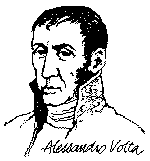 In 1786, Luigi Galvani, an Italian professor of medicine, found that
when the leg of a dead frog was touched by a metal knife, the leg
twitched violently. Galvani thought that the muscles of the frog must
contain electricity. By 1792 another Italian scientist, Alessandro
Volta, disagreed: he realised that the main factors in Galvani's
discovery were the two different metals - the steel knife and the tin
plate - apon which the frog was lying. Volta showed that when moisture
comes between two different metals, electricity is created. This led him
to invent the first electric battery, the voltaic pile, which he made
from thin sheets of copper and zinc separated by moist pasteboard.
In 1786, Luigi Galvani, an Italian professor of medicine, found that
when the leg of a dead frog was touched by a metal knife, the leg
twitched violently. Galvani thought that the muscles of the frog must
contain electricity. By 1792 another Italian scientist, Alessandro
Volta, disagreed: he realised that the main factors in Galvani's
discovery were the two different metals - the steel knife and the tin
plate - apon which the frog was lying. Volta showed that when moisture
comes between two different metals, electricity is created. This led him
to invent the first electric battery, the voltaic pile, which he made
from thin sheets of copper and zinc separated by moist pasteboard.
 The credit for generating electric current on a practical scale goes to
the famous English scientist, Michael Faraday. Faraday was greatly
interested in the invention of the electromagnet, but his brilliant mind
took earlier experiments still further. If electricity could produce
magnetism, why couldn't magnetism produce electricity.
The credit for generating electric current on a practical scale goes to
the famous English scientist, Michael Faraday. Faraday was greatly
interested in the invention of the electromagnet, but his brilliant mind
took earlier experiments still further. If electricity could produce
magnetism, why couldn't magnetism produce electricity.
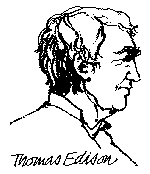 Nearly 40 years went by before a really practical DC (Direct Current)
generator was built by Thomas Edison in America. Edison's many
inventions included the phonograph and an improved printing telegraph.
In 1878 Joseph Swan, a British scientist, invented the incandescent
filament lamp and within twelve months Edison made a similar discovery
in America.
Nearly 40 years went by before a really practical DC (Direct Current)
generator was built by Thomas Edison in America. Edison's many
inventions included the phonograph and an improved printing telegraph.
In 1878 Joseph Swan, a British scientist, invented the incandescent
filament lamp and within twelve months Edison made a similar discovery
in America.
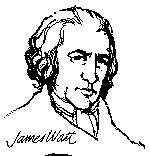 When Edison's generator was coupled with Watt's steam engine, large
scale electricity generation became a practical proposition. James Watt,
the Scottish inventor of the steam condensing engine, was born in 1736.
His improvements to steam engines were patented over a period of 15
years, starting in 1769 and his name was given to the electric unit of
power, the Watt.
When Edison's generator was coupled with Watt's steam engine, large
scale electricity generation became a practical proposition. James Watt,
the Scottish inventor of the steam condensing engine, was born in 1736.
His improvements to steam engines were patented over a period of 15
years, starting in 1769 and his name was given to the electric unit of
power, the Watt.
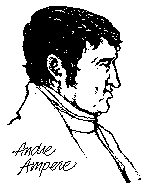
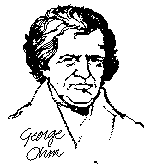 Andre
Marie Ampere, a French mathematician who devoted himself to the study
of electricity and magnetism, was the first to explain the
electro-dynamic theory. A permanent memorial to Ampere is the use of his
name for the unit of electric current.
George Simon Ohm, a German mathematician and physicist, was a
college teacher in Cologne when in 1827 he published, "The galvanic
Circuit Investigated Mathematically". His theories were coldly received
by German scientists but his research was recognised in Britain and he
was awarded the Copley Medal in 1841. His name has been given to the
unit of electrical resistance
Andre
Marie Ampere, a French mathematician who devoted himself to the study
of electricity and magnetism, was the first to explain the
electro-dynamic theory. A permanent memorial to Ampere is the use of his
name for the unit of electric current.
George Simon Ohm, a German mathematician and physicist, was a
college teacher in Cologne when in 1827 he published, "The galvanic
Circuit Investigated Mathematically". His theories were coldly received
by German scientists but his research was recognised in Britain and he
was awarded the Copley Medal in 1841. His name has been given to the
unit of electrical resistance
 In 1786, Luigi Galvani, an Italian professor of medicine, found that
when the leg of a dead frog was touched by a metal knife, the leg
twitched violently. Galvani thought that the muscles of the frog must
contain electricity. By 1792 another Italian scientist, Alessandro
Volta, disagreed: he realised that the main factors in Galvani's
discovery were the two different metals - the steel knife and the tin
plate - apon which the frog was lying. Volta showed that when moisture
comes between two different metals, electricity is created. This led him
to invent the first electric battery, the voltaic pile, which he made
from thin sheets of copper and zinc separated by moist pasteboard.
In 1786, Luigi Galvani, an Italian professor of medicine, found that
when the leg of a dead frog was touched by a metal knife, the leg
twitched violently. Galvani thought that the muscles of the frog must
contain electricity. By 1792 another Italian scientist, Alessandro
Volta, disagreed: he realised that the main factors in Galvani's
discovery were the two different metals - the steel knife and the tin
plate - apon which the frog was lying. Volta showed that when moisture
comes between two different metals, electricity is created. This led him
to invent the first electric battery, the voltaic pile, which he made
from thin sheets of copper and zinc separated by moist pasteboard.
In this way, a new kind of electricity was discovered, electricity
that flowed steadily like a current of water instead of discharging
itself in a single spark or shock. Volta showed that electricity could
be made to travel from one place to another by wire, thereby making an
important contribution to the science of electricity. The unit of
electrical potential, the Volt, is named after Volta.
Michael Faraday
 The credit for generating electric current on a practical scale goes to
the famous English scientist, Michael Faraday. Faraday was greatly
interested in the invention of the electromagnet, but his brilliant mind
took earlier experiments still further. If electricity could produce
magnetism, why couldn't magnetism produce electricity.
The credit for generating electric current on a practical scale goes to
the famous English scientist, Michael Faraday. Faraday was greatly
interested in the invention of the electromagnet, but his brilliant mind
took earlier experiments still further. If electricity could produce
magnetism, why couldn't magnetism produce electricity.
In 1831, Faraday found the solution. Electricity could be produced
through magnetism by motion. He discovered that when a magnet was moved
inside a coil of copper wire, a tiny electric current flows through the
wire. Of course, by today's standards, Faraday's electric dynamo or
electric generator was crude, and provided only a small electric current
be he discovered the first method of generating electricity by means of
motion in a magnetic field.
Thomas Edison and Joseph Swan
 Nearly 40 years went by before a really practical DC (Direct Current)
generator was built by Thomas Edison in America. Edison's many
inventions included the phonograph and an improved printing telegraph.
In 1878 Joseph Swan, a British scientist, invented the incandescent
filament lamp and within twelve months Edison made a similar discovery
in America.
Nearly 40 years went by before a really practical DC (Direct Current)
generator was built by Thomas Edison in America. Edison's many
inventions included the phonograph and an improved printing telegraph.
In 1878 Joseph Swan, a British scientist, invented the incandescent
filament lamp and within twelve months Edison made a similar discovery
in America.
Swan and Edison later set up a joint company to produce the first
practical filament lamp. Prior to this, electric lighting had been my
crude arc lamps.
Edison used his DC generator to provide electricity to light his
laboratory and later to illuminate the first New York street to be lit
by electric lamps, in September 1882. Edison's successes were not
without controversy, however - although he was convinced of the merits
of DC for generating electricity, other scientists in Europe and America
recognised that DC brought major disadvantages.
George Westinghouse and Nikola Tesla
Westinghouse was a famous American inventor and industrialist
who purchased and developed Nikola Tesla's patented motor for generating
alternating current. The work of Westinghouse, Tesla and others
gradually persuaded American society that the future lay with AC rather
than DC (Adoption of AC generation enabled the transmission of large
blocks of electrical, power using higher voltages via transformers,
which would have been impossible otherwise). Today the unit of
measurement for magnetic fields commemorates Tesla's name.
James Watt
 When Edison's generator was coupled with Watt's steam engine, large
scale electricity generation became a practical proposition. James Watt,
the Scottish inventor of the steam condensing engine, was born in 1736.
His improvements to steam engines were patented over a period of 15
years, starting in 1769 and his name was given to the electric unit of
power, the Watt.
When Edison's generator was coupled with Watt's steam engine, large
scale electricity generation became a practical proposition. James Watt,
the Scottish inventor of the steam condensing engine, was born in 1736.
His improvements to steam engines were patented over a period of 15
years, starting in 1769 and his name was given to the electric unit of
power, the Watt.
Watt's engines used the reciprocating piston, however, today's
thermal power stations use steam turbines, following the Rankine cycle,
worked out by another famous Scottish engineer, William J.M Rankine, in
1859.
Andre Ampere and George Ohm

 Andre
Marie Ampere, a French mathematician who devoted himself to the study
of electricity and magnetism, was the first to explain the
electro-dynamic theory. A permanent memorial to Ampere is the use of his
name for the unit of electric current.
Andre
Marie Ampere, a French mathematician who devoted himself to the study
of electricity and magnetism, was the first to explain the
electro-dynamic theory. A permanent memorial to Ampere is the use of his
name for the unit of electric current.
Where is tesla man
ReplyDeletethis blog consisting of very nice information i got more knowledge after reading this blog.we are offering hibernate online training for more visit
ReplyDeleteMore than 38 Electrical companies in Dubai are ready to serve you in the Rafeeg App. They offer a competitive price, quality assurance, and prompt response to your request.
ReplyDeleteCadence Electrical is one of the leading Electrical Companies in Delhi NCR, providing top-notch electrical services to both residential and commercial clients. With a team of highly skilled and experienced electricians, Cadence Electrical offers a wide range of electrical services, including installation, repair, and maintenance of electrical systems.
ReplyDeleteSydney electrician is a lifesaver! They responded quickly to my electrical emergency and fixed the issue with expertise. Highly recommended.
ReplyDelete